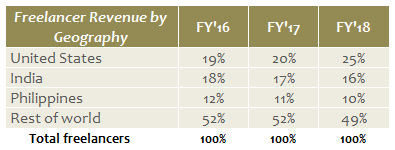Summary Freelancers will no longer have free access to the platform; Upwork does not consider freelancer retention metrics essential; It remains to be seen whether extra revenues will outweigh some drawbacks of this action on the part of the company. In October last year, when Upwork ( UPWK ) was already a public company, I wrote a valuation piece, which consisted of two parts ( here and here ), in which I showed company’s value was around $14 and that it was overvalued at $20 price it was trading at that time. Six months through and one 10K report, nothing has changed fundamentally, in my view, to re-assess that narrative; nor has there been any impressive performance on the part of the company. Interestingly, and perhaps due to unimpressive revenue growth rates, just yesterday, Upwork CEO Stephane Kasriel announced of an impending change in the way the company was going to engage with freelancers going forward. With this change in mind, it is interesting to consider what repercussions, if any, this may or will have for the company. What is changing? According to the announcement, starting in May this year, freelancers will have to pay to obtain the so-called ‘Connects’ tokens to gain access to the platform. Historically, freelancers received 60 free Connects each month, which they could then use to send proposals to the projects posted by clients (with the “cost” of sending those proposals ranging from 1-6 Connects per each proposal). While freelancers were able to purchase more Connects, if they needed, it was not necessary or required, given that 60 may have been just enough for them. With this privilege comes a cost in the form of Upwork charging a tiered ‘take-rate’ as a platform, where freelancers and clients meet, which, on average, stands at around 13%. Now, however, freelancers will have to pay $0.15 per Connect on top of that, and this is where things are getting interesting. What sort of issue are we talking about? An essential thing to begin with is to look at who the typical freelancer is. According to the latest 10K report and S-1 report filed during the IPO, freelancers come from the following regions: While it is the case that the United States still accounts for the greatest proportion of freelancers, this is so only on individual-country basis. Two of the countries that follow, India and Pakistan, have the same revenue contribution when combined, and there are more countries with low per-capita incomes in the ‘Rest of the World’ category (for some background look at this link ). Meanwhile, revenue generation by client shows a completely different picture: Most of the revenue generated from clients comes from the US. This very factor of US-located clients, on the one hand, and freelancers located in low-income countries, on the other, had been the value proposition I referred to in my earlier report on the company. Given this change, these freelancers may now be reluctant to spend their money purchasing Connects, given […]




